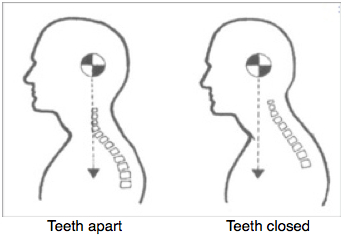TMJ, TMD, Temporal-Mandibular Disorders, and the Orthotic Mouthguard
TMJ treatment in dentistry is confused, and confusing. Many theories exist to explain why people get jaw tension and pain, but they all center around the teeth and the temporo-mandibular joints that attach the jaw to the skull. In our practice, we add lessons learned from chiropractors and osteopaths, and concentrate on the postural relationship of the jaw with the head and neck. This approach lets us get at the whole complex of upper body tension that creates TMJ symptoms, simply and rapidly.
Is this you? (clicking, popping, clenching, grinding, tight jaw, worn-down teeth, facial pain, headache, neck tension, some or all of the above)
All these symptoms are the result of chronic, inappropriate muscle tension around the head, neck, and face, and especially of the jaw muscles. It’s true that many kinds of stresses can play into the problem, from injuries, to stressful life situations, to the ergonomics of your work space. But the great underlying factor, common to all TMJ cases, is a conflict between the posture of the jaw when you close your teeth, and the posture of your neck.
Jaw versus Neck
 There is a relationship between the posture of the jaw when the teeth are closed, and the posture of the neck.
There is a relationship between the posture of the jaw when the teeth are closed, and the posture of the neck.
It seems that for a great many people, putting the teeth together forces them to bend the neck to some extent. It’s a mechanical thing about posture. Closing the teeth draws the head into a forward posture and kinks the neck.
Many such people do not have any symptoms. Many people live perfectly well with crazy, weird bites. But many do not, and often a stressful situation or an injury tips them into being symptomatic.
The Vicious Circle of jaw v. neck tension
When there is pain, or subliminal pain in your neck, your brain calls upon the muscles of the whole region to tighten, and brace up the neck. That includes the muscles of the shoulders, the sides of the neck, back of the head, and the jaw. People clench their teeth, grind their teeth, posture their jaw, all in an unconscious, reflexive effort to brace up the neck. After some time, those muscles get tired and start to hurt. For some people, the constant pulling on the jaw joint gets it to click. For others, the teeth eventually wear down.
But when the muscles of the jaw tense and the teeth are held together, you are actually kinking your neck, and holding it in a stressed posture! That’s the negative feedback loop:
- pain and subliminal pain in the neck create muscle tension, including in the jaw;
- tension in the jaw keeps the neck in a stressed posture;
- and around and around they go, hurting each other.
The Cranial – Cervical Approach to TMJ
In nearly all cases of jaw tension, (pain, clenching, grinding, etc.) the real problem starts in the neck. Tension in the neck provides the signals that trigger most jaw tension. Our job, as dentists trained in the diagnostic techniques of chiropractic and osteopathy, is to find a position for your jaw that neutralizes the tension in your neck.
We use several different diagnostic methods to reach that goal, including applied kinesiology (muscle testing) and cranial palpation. This allows us to get good answers very quickly, without a prolonged and overly expensive series of appointments. Joint x-rays are rarely indicated.
We typically make an orthotic mouth guard that goes on the lower teeth, to defuse the impulses that tense your jaw muscles. An orthotic is a device for correcting posture. Foot orthotics worn in the shoes are the most familiar kind. An orthotic mouth guard takes advantage of the simple fact that there are two locations in the body where your posture is stabilized: at the bottom end of your body, it is the way your feet meet the floor; at the top end, it is the way your teeth come together. Foot orthotics can correct fallen arches and pronated ankles, and thereby relieve lower back pain. A properly calibrated mouth orthotic can correct the posture of the jaw, and relieve most types of excess jaw-and-neck tension.
An orthotic device works when you use it, and does not work when you don’t. It is not an orthodontic device, and will not move or straighten teeth.
They are usually made of heat processed acrylic, a material of very low allergenic potential. Most patients find our mouth guards to be comfortable right away. Any discomfort that arises can be quickly resolved. These mouth guard do need periodic adjustment and maintenance, so follow up appointments are recommended.
This type of orthotic mouth guard treatment is not meant to replace the other appropriate forms of therapy, such as physical therapy, massage, osteopathic or chiropractic treatment. It is meant to be supportive, and we like to work with, and communicate with, your other providers.
